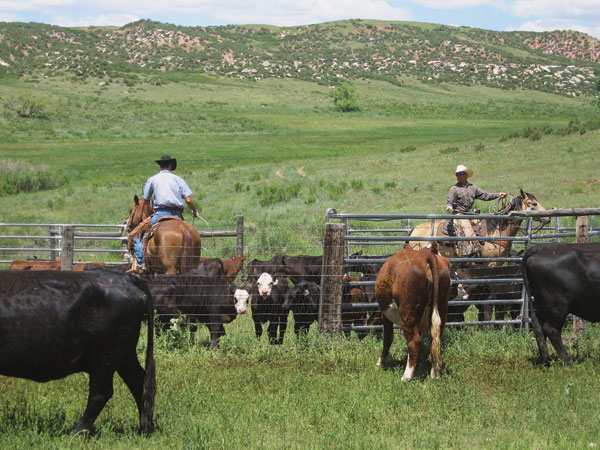Early weaning puts this ranch on stronger footing and it can more readily survive 1-2 bad years out of a dozen, rather than barely getting by.
June 22, 2012

Maxwell Ranch near Fort Collins, CO, utilizes early weaning as a way to reduce costs.
Joel Vaad, who manages the ranch, says he’s been weaning calves at 4-5 months of age; pulling them right off the cows to sell. “I wean my replacement heifers at the same age and they do fine,” he says.
“A few years ago, to save hay, we set our calving later. We have no hay ground and all winter feed is purchased. High hay prices forced us to change our calving season. We used to calve in February-March and, in this climate, you must have the cows confined during calving – for shelter and supervision. That means feeding hay.”
Maxwell Ranch used to feed 550 tons of hay each winter to 300 cows. “We used to wean a 550-lb. steer in late October-early November. Calving later, we now wean a 430-lb. steer in November, and put less hay through the cows. Last year, we fed 78 tons, total, to the herd; that includes replacement heifers,” Vaad says.
The heifers are on a weaning program for 60 days, then go back with the cows; they all run together on pasture. “During the cows’ last trimester, I supplement with protein. That’s the only supplemental feed they get, unless we have snow,” he says.
“This is one reason I use alfalfa hay as supplemental protein. The other reason is that alfalfa hay is the cheapest protein supplement I’ve found. Even at $185/ton (2011 price), it was cost effective.”
Early weaning has decreased cost inputs, he adds. Even though calves are smaller at weaning, expenses for the cow-calf unit are significantly decreased.
“Last year, if we’d calved in February, our calf check would have been an additional $8,000 (with bigger calves in the fall), but we’d have put an extra $42,000 of feed through the cows to gain that $8,000.”
Not for everyone
“For us, this is working great. By contrast, I have a neighbor just 15 miles up the highway and he gets more snow. If they get snow in November, their ground is snow-covered until April. You can’t make generalizations and say everyone can save hay by doing what we’re doing.”
Vaad thinks that if those still calving in February could save part of their hay supply, however, it might make a big difference on their bottom line. Cost of hay is a major factor in beef operations today.
“I did a thorough evaluation before we changed our calving season. I compared our February-March calving season with an April-May calving season and a May-June calving season, trying to determine what might work best for us. I plugged in high calf prices and low feed prices, high calf prices and high feed prices, and so on – all the possibilities,” he says.
“When hay was cheap, early calving worked okay, putting that feed through our cows. But that was the only scenario when February-March seemed the best time to calve – good calf prices and low feed prices. In all other scenarios, the May-June calving appeared to work best. April-May calving would probably have been our worst option because we’d still be weaning a lighter calf and still feeding a significant amount of hay in the spring for those cows,” he explains.
“If cattle prices stay as they are, maybe you can still afford to calve in February. But I was trying to not have to depend on outside sources for our hay, or have hay prices dictate the way things are done on our place. I had to figure out what resources we have available, at the lowest possible cost, and how best to work with that. So far, later calving/early weaning is my best answer,” Vaad says.
“One of these years we’ll probably have a big snow and end up feeding a lot of hay. We’ll probably lose money that year, but the other 10 or so years we can easily make up for that. This puts the ranch on stronger footing and it can more readily survive 1-2 years out of a dozen, rather than barely getting by.”
Another bonus of early-weaned calves is more marketing options.
“With the 550-lb. calf, you’re pretty much locked into it being a feeder steer. With the 430-lb. calf, someone could still make it a feeder steer but could also run that calf on wheat pasture or go to grass,” he says. These calves can be backgrounded cheaply and grown a lot bigger before they go into the feedlot.
You May Also Like



